Your feet play a starring role in your running. They withstand force up to three times your body weight with each step and trigger the propulsion that moves you forward. It’s no wonder runners often suffer from foot pain from running.
Running is a cherished activity for many, yet for some runners, the joy of hitting the pavement is overshadowed by the nagging question: Why do my feet hurt when I run?
Foot pain is a common complaint among runners, stemming from a variety of causes that can range from overuse injuries to biomechanical issues.
In this comprehensive guide, we delve into the factors contributing to foot pain from running and provide practical solutions to alleviate discomfort and keep you moving forward.
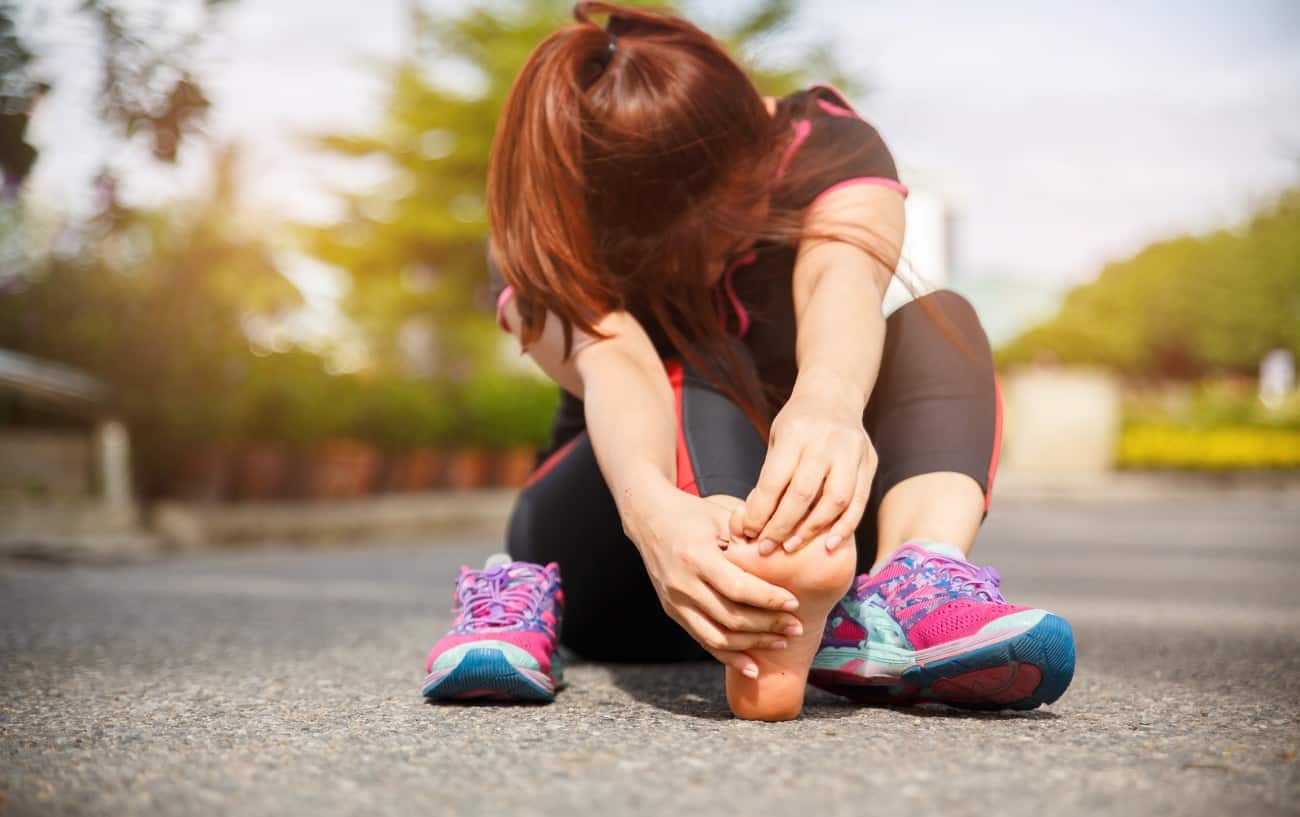
8 Common Causes of Foot Pain From Running
Let’s take a look at the most common causes of foot pain from running and how to stop foot pain while running.1van der Worp, M. P., ten Haaf, D. S. M., van Cingel, R., de Wijer, A., Nijhuis-van der Sanden, M. W. G., & Staal, J. B. (2015). Injuries in Runners; A Systematic Review on Risk Factors and Sex Differences. PLOS ONE, 10(2), e0114937. https://doi.org/10.1371/journal.pone.0114937
#1: Plantar Fasciitis
Plantar fasciitis is a common foot problem, likely the most common cause of foot pain from running. Your plantar fascia is a web-like tissue that stretches across the bottom of your foot from your heel bone to your toe.
Pain from plantar fasciitis is most commonly felt as heel pain or in the arch of the foot where the heel graduates into the arch. The pain can be a sharp stabbing pain and/or a dull ache.
If your plantar fascia becomes too tight, it can become inflamed, strained, or even torn.
Does plantar fasciitis go away? Yes, but plantar fasciitis is one of the most problematic foot conditions and foot injuries.
If you suspect you have plantar fasciitis, it is best to take care of it right away, as it can become inflamed quickly and is hard to get rid of.
Here’s how to treat plantar fasciitis:
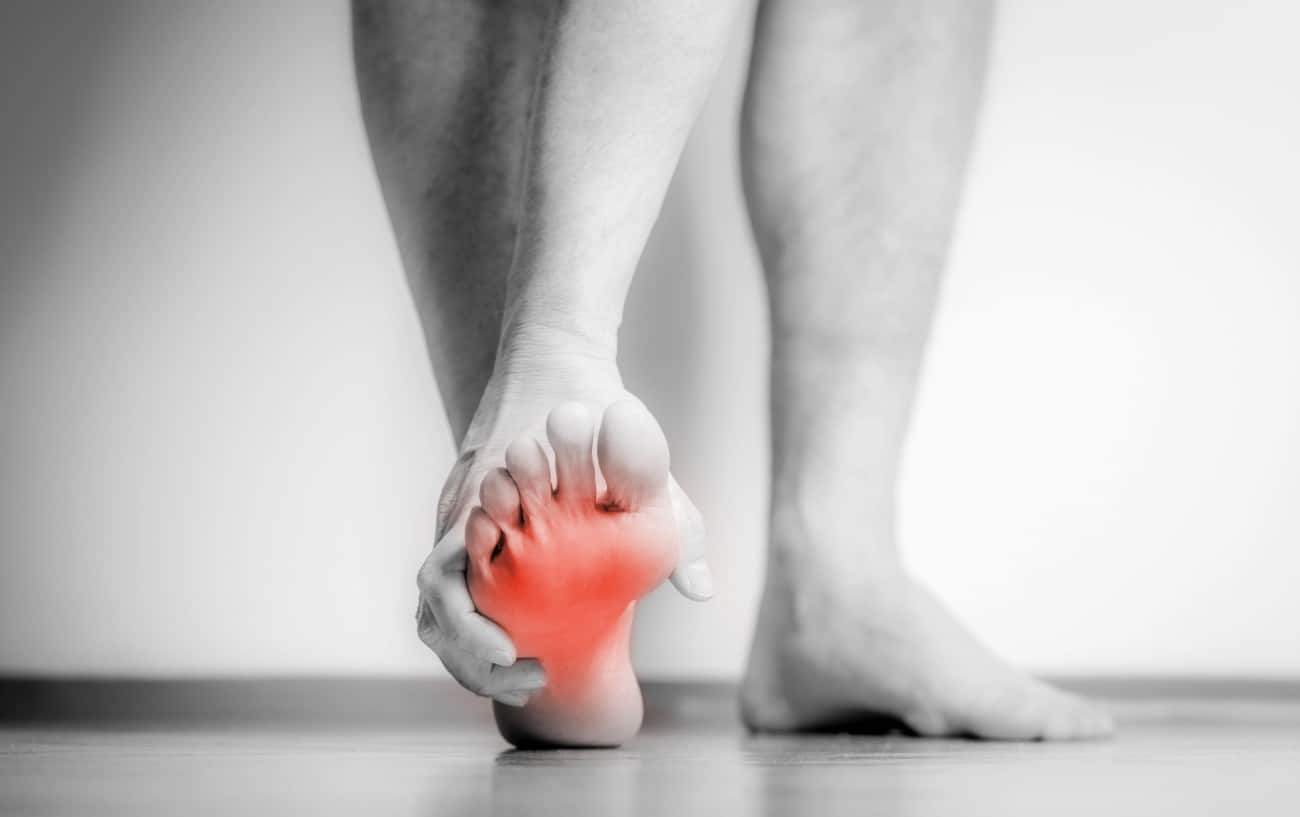
- Stretch and roll your calf. Stretch your calves 3 times for 20 seconds 3 times a day by dropping your heel off a step. Do not do this if this hurts! Also, foam roll your calf.
- Stretch your plantar fascia. While sitting on the ground, loop a belt or band around the ball of the foot. Pull towards you and hold for 20 seconds. Repeat 3 times 3 times a day. Also, get a golf ball or lacrosse ball. Place it under your foot and roll it around the foot arch area.
- Ice and heat. Do an ice foot bath followed by a warm foot bath to increase circulation and help decrease inflammation. You can also roll your foot on a ball while in an Epsom salt bath.
- Take a break from running. Should I still run if my foot hurts? If running causes pain to your big toe during or after, then take a break and find a cross-training activity you like instead.
- Consider injections. A cortisone shot may help bring the inflammation down. Platelet Rich Plasma (PRP) injections drawn from your own blood into the injured area can help healing, as can surgery.
- Physical therapy. Progressive physical activity in the affected area can help you get back to pain-free, strong running.
#2: Stress Fractures
There are 26 bones in your foot, and these bones are under a lot of stress when you’re running! If you have acute, localized pain, there is a good chance one of these bones could have a stress fracture.
These tiny cracks or severe bruising are a common overuse injury in runners—typically in the metatarsal bones (the middle bones of your foot). They can also be in the heel, ankle joint, or top of the foot (navicular).
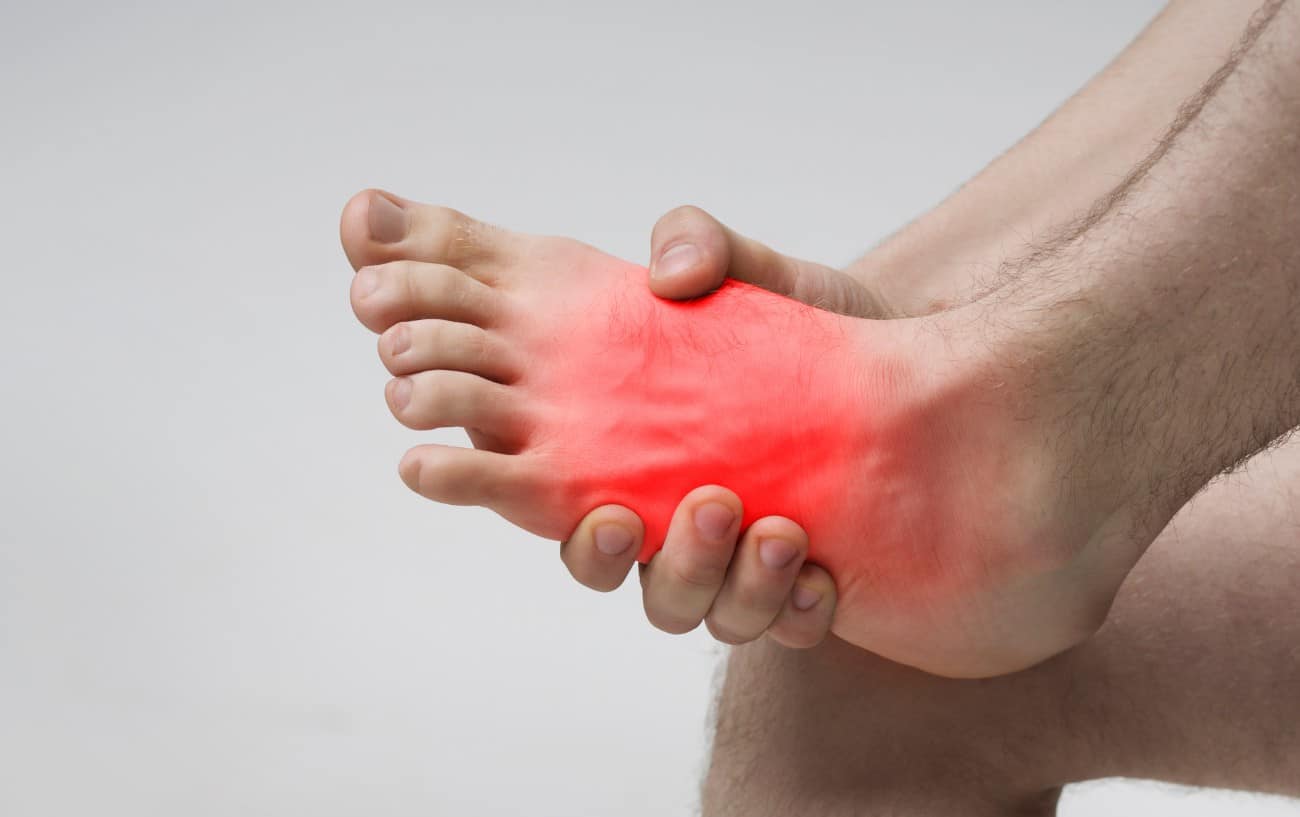
Here’s how to treat a stress fracture:
- See a doctor. If you suspect you have a stress fracture, it is important to see a doctor and get imaging to diagnose the problem.
- Practice RICE. RICE stands for rest, ice, compression, and elevate. These are steps you will likely take to help spur healing.
- Focus on nutrition. Eating a well-balanced diet of healthy, whole foods, including meat, dairy, and leafy greens, will also help bone remodeling.
- Wear a medical boot. During this time off, you will probably have to wear a boot and find a cross-training activity that does not aggravate your foot such as swimming or cycling. You will likely need to take about 4 to 8 weeks off running.
#3: Hallux Rigidus
Your big toe plays a starring role in your running.
The joint of your big toe, where the metatarsophalangeal, or MTP, connects to the metatarsal bone in the forefoot to the phalanx, the bottom bone of the big toe, is where a lot of the propulsion comes from in your stride.
As you run, your big toe joint bends to allow your foot to roll forward and “toe-off” off the ground.
With your MTP literally bearing the weight of your running, it is prone to becoming stiff. And that’s exactly what “hallux rigidus” means—stiff big toe. Hallux rigidus can also be called turf toe or simply stiff big toe.
This stiffness can be caused by osteoarthritis or inflammation in the joint from overuse. You can also sprain or stub this joint.
If you have big toe pain, it’s likely it will get worse and you’ll have less mobility in the joint over time.
This means you need to treat it.
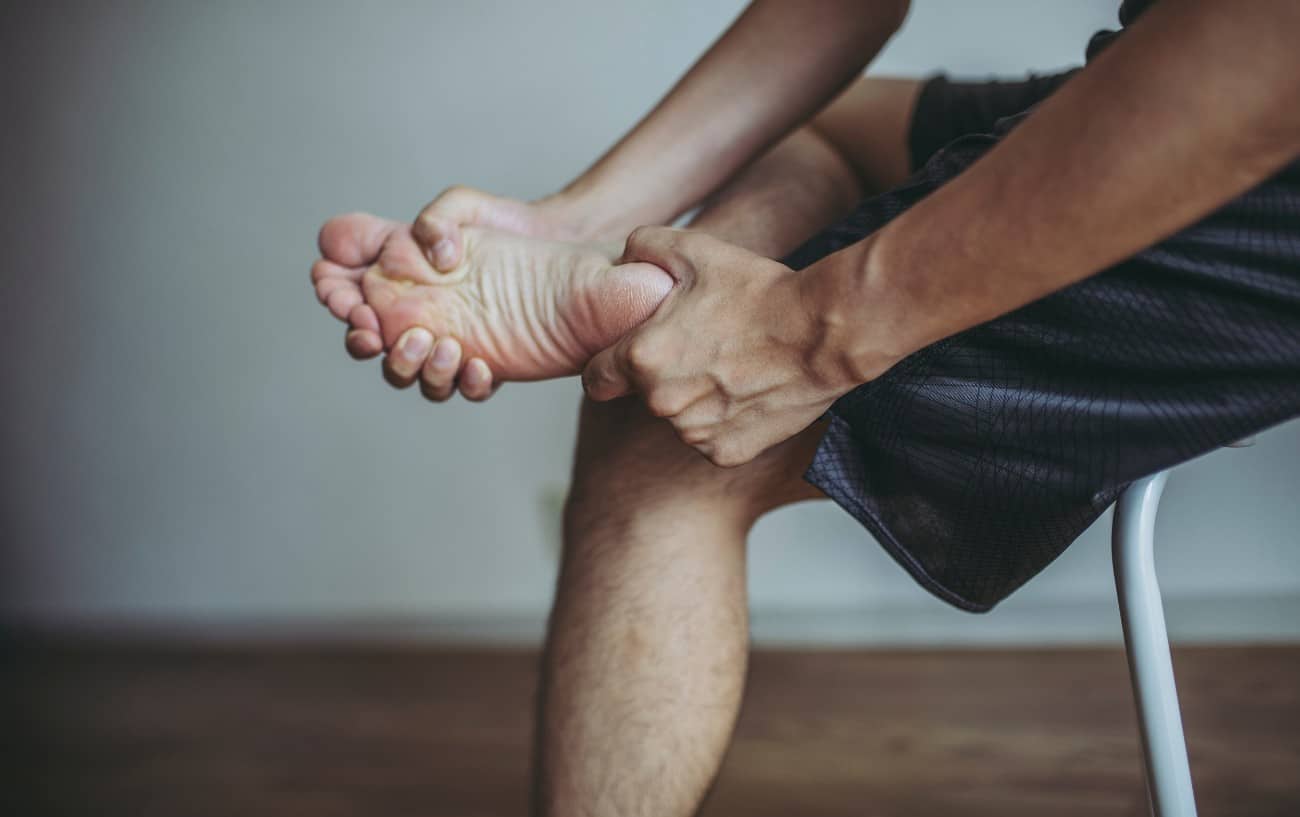
Here’s how to treat Hallux Rigidus:
- Wear proper shoes. Wear shoes that provide support for your feet. Running shoes are probably your best choice. This will limit further stress on the MTP joint.
- Stretch the toe joint. Pull your big toe towards you and hold for 15 to 30 seconds. Repeat by pulling it down and then side to side. Repeat two to four times three times a day. This improves mobility (which will also help your running!)
- Ice and heat. Do an ice foot bath followed by a warm foot bath to increase circulation to help decrease inflammation.
- Take a break from running. If running causes pain to your big toe during or after, then take a break and find a cross-training activity you like instead.
- Take anti-inflammatories. Regular use of anti-inflammatories and a cortisone shot may help calm the inflammation down. If you have a cortisone shot, you will definitely need to take a break from running as it can weaken the tissue.
#4: Metatarsalgia
Metatarsalgia is the inflammation of the tissues surrounding your metatarsals, or the five long bones in your foot.2Manganaro, D., Dollinger, B., Nezwek, T. A., & Sadiq, N. M. (2021). Anatomy, Bony Pelvis and Lower Limb, Foot Joints. PubMed; StatPearls Publishing. https://www.ncbi.nlm.nih.gov/books/NBK536941/
It is a common overuse injury that feels like a stabbing, burning, or aching feeling under the toes or pain in the ball of your foot. You may also have numbness or tingling in your toes. It will also hurt when you flex your foot.

Metatarsalgia is an injury you want to take care of right away.
Here’s how to treat Metatarsalgia:
- Practice RICE. Rest, ice, compression, and elevate. You can do a contrast bath of ice and heat to get the inflammation down and take anti-inflammatories to ease the pain.
- Cross-train. You shouldn’t run with metatarsalgia and you likely won’t want to. Find another exercise that doesn’t aggravate your foot.
- Wear supportive shoes. Consider wearing your running shoes, Oofos sandals, or even a boot to reduce the impact on the irritated area. Metatarsal pads and custom orthotics may ease the pain.
- Call your doctor. If your foot is not better after ten days of at-home treatment, see a doctor.
#5: Fat pad syndrome
Your feet are lined with a fat pad that cushions your heel and absorbs the shock of running. This fat pad can become irritated from overuse, running on hard surfaces, or wearing improper shoes.

Here’s how to treat fat pad syndrome:
- Contrast baths. Soak your hurting foot in ice water for 10 minutes and then switch to warm water. Do this throughout the day.
- Wear cushioned shoes. Oofos or your running shoes may provide proper support as could the addition of a heel cup.
- Tape your heel. Taping your heel with kinesiology tape will promote blood flow to help get rid of inflammation.
- Massage. You can massage your own foot manually, with a massage gun, or book a massage and have them focus on your foot.
- Get some podiatry from a podiatrist. If your foot doesn’t feel better after 10 days of at-home treatment, see a doctor and get an official diagnosis.
#6: Morton’s Neuroma
What is a Morton’s Neuroma?
Morton’s Neuroma causes sharp, burning pain, often between the third and fourth toes, due to the thickening of tissue around a nerve.
Managing it involves wearing proper shoes with a wide toe box and cushioning, using orthotic inserts for support and pressure distribution, modifying activities to avoid aggravating symptoms, applying ice several times a day, and doing stretching exercises.
#7: Achilles Tendonitis
Achilles Tendonitis, characterized by inflammation of the Achilles tendon, leads to pain and stiffness near the heel.
Management includes resting and modifying activities to allow healing, strengthening exercises for lower limb stability, and using proper footwear with cushioning and support and gradually returning to activity.
#8: Ankle Sprains
Ankle sprains result from stretched or torn ligaments due to sudden foot movements or overuse.
Management involves the R.I.C.E. protocol (rest, ice, compression, elevation) immediately, immobilizing the ankle with a brace or wrap, starting rehabilitation exercises once swelling decreases, and gradually returning to running with proper footwear and support.
8 Tips to Prevent Foot Pain From Running
What is the best way to prevent foot pain from occurring in the first place?
Foot pain from running can be tricky to get rid of because we are always on our feet. The good news is there are steps to prevent foot pain from running in the first place!3van Gent, R. N., Siem, D., van Middelkoop, M., van Os, A. G., Bierma-Zeinstra, S. M. A., Koes, B. W., & Taunton, J. E. (2007). Incidence and Determinants of Lower Extremity Running Injuries in Long Distance runners: A Systematic Review. British Journal of Sports Medicine, 41(8), 469–480. https://doi.org/10.1136/bjsm.2006.033548

#1: Wear Proper Running Shoes
Make sure you are wearing the right shoes for your running gait. Get new shoes once you’ve reached the mileage cap. Most shoes last about 200 miles.
#2: Alternate Running Shoes
How can I tell if my running shoes are causing foot pain? If no other variables have changed, but your shoes have become very worn out or are brand new, then the shoes may be to blame.
Wearing two types of properly fitting running shoes can help negate biomechanical patterns that lead to overuse injuries. Variety is the spice of life, and it can be the key to injury prevention and avoiding foot pain from running.
Make sure you find your running shoes comfortable!4Nigg, B., Baltich, J., Hoerzer, S., & Enders, H. (2015). Running shoes and running injuries: mythbusting and a proposal for two new paradigms: “preferred movement path” and “comfort filter.” British Journal of Sports Medicine, 49(20), 1290–1294. https://doi.org/10.1136/bjsports-2015-095054
Check out our pick for: What are the best running shoes for avoiding foot pain?
#3: Consider Orthotics
Healthcare providers may offer custom orthotics that can help correct biomechanical issues and offer arch support that may be the cause of your injuries. See a physical therapist or podiatrist to get orthotics that correct issues in your biomechanics.
#4: Run On Soft Surfaces
If you have the option to run on grass, gravel, dirt, or asphalt, do it! Avoid hard surfaces like concrete or cement.
#5: Do Toe Yoga
Toe yoga, where you lift your big toe independently of your little toes, and alternate, can help keep the foot healthy and strong. Perform this exercise 60 times on each foot at least once per day.
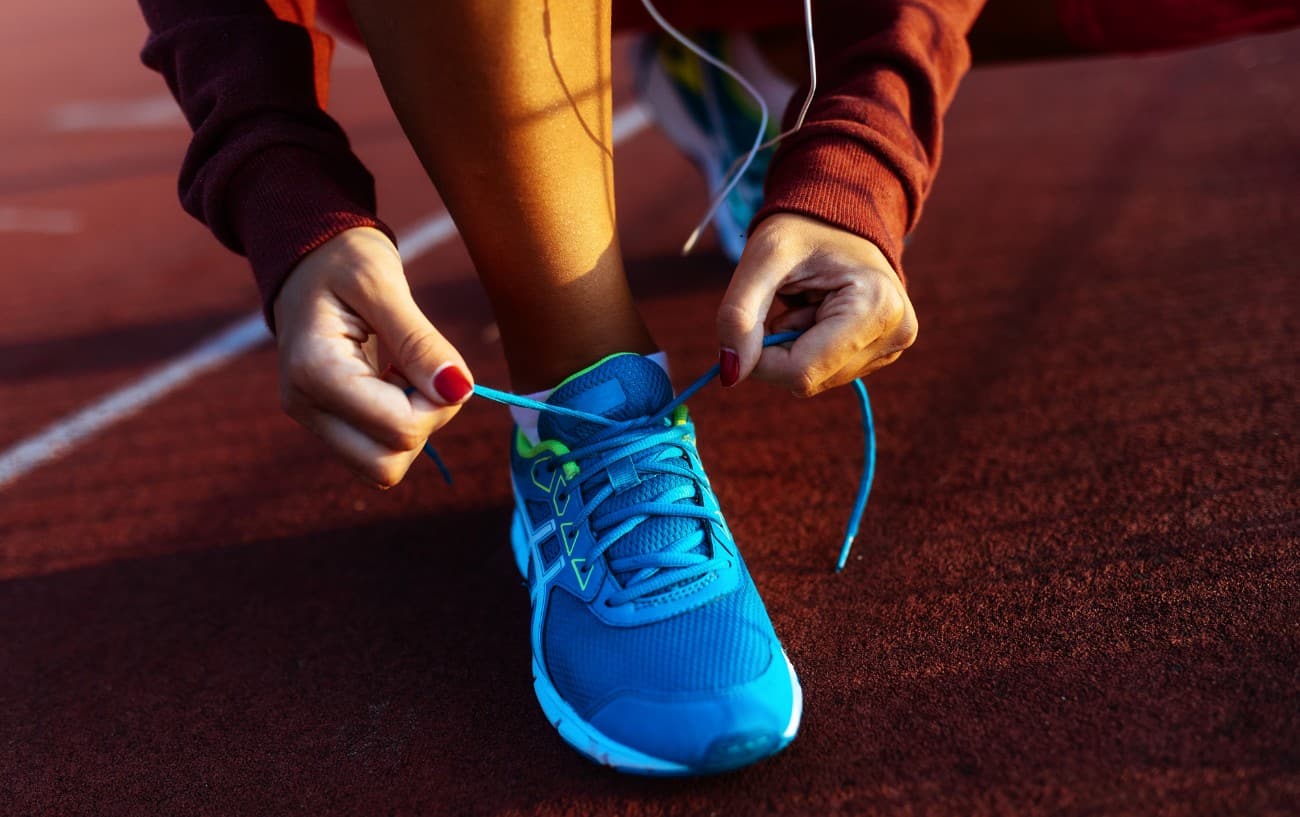
#6: Gradually Increase Volume
Most overuse injuries, including those that cause foot pain from running, occur due to too much too soon for your body. Adhere to the 10 percent rule of increasing volume week over week and taking rest days.
#7: Get Your Gait Checked
Have a physical therapist check your running. Running injuries are also caused by running form issues. Also, have them check your feet to ensure no issues are budding.
#8: See A Specialist
Don’t wait to see a doctor or your physical therapist when you begin having foot pain from running.
Whether flat feet, bunions, an inflamed band of tissue, or any of the aforementioned ailments it’s better to act fast because foot pain can take a long time to heal and a specialist can best guide your specific situation on how to stop foot pain when running.
We’d love to help you with your training goals, whether for the 5k, an ultramarathon, or simply staying healthy. Check out:
